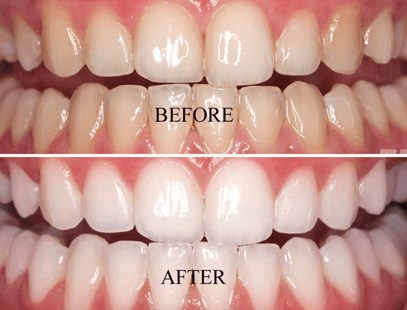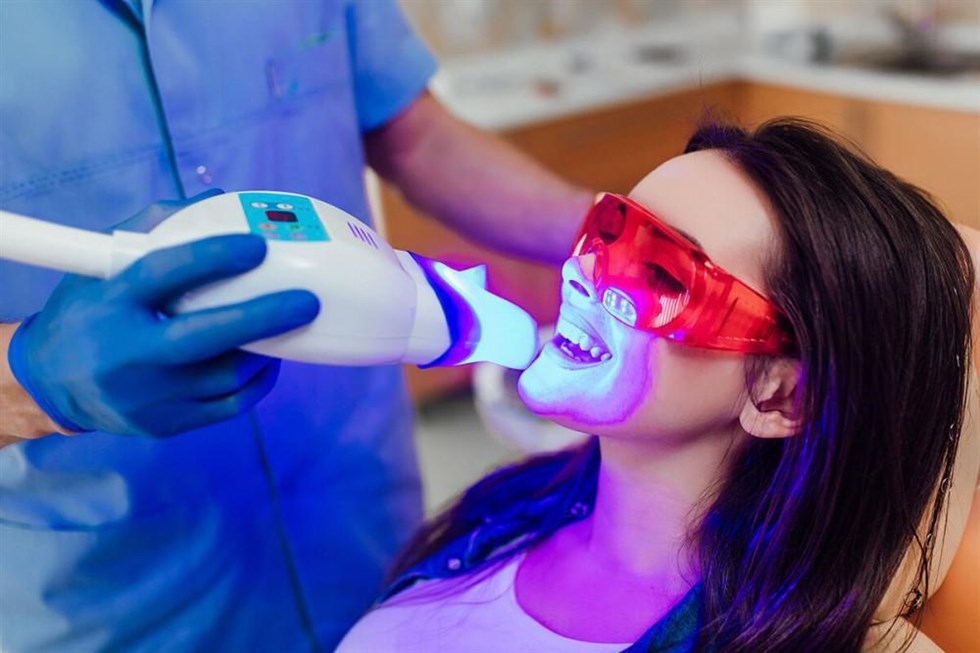

Teeth whitening, is a common procedure in general dentistry. According to the FDA, whitening restores natural tooth color and bleaching whitens beyond the natural color. There are many methods available, such as brushing, bleaching strips, bleaching pen, bleaching gel, and laser bleaching.
Bleaching methods use carbamide peroxide which reacts with water to form hydrogen peroxide. Carbamide peroxide has about a third of the strength of hydrogen peroxide. This means that a 15% solution of carbamide peroxide is the rough equivalent of a 5% solution of hydrogen peroxide. The peroxide oxidizing agent penetrates the porosities in the rod-like crystal structure of enamel and breaks down stain deposits in the dentin. Power bleaching uses light to accelerate the process of bleaching in a dental office. Another bleaching agent is 6-phthalimido peroxy hexanoic acid (PAP).
Causes of tooth discoloration
A child's deciduous teeth are generally whiter than the adult teeth that follow. As a person ages the adult teeth often become darker due to changes in the mineral structure of the tooth, as the enamel becomes less porous vegetables rich with carotenoids or xanthonoids. Certain antibacterial medications (like tetracycline) can cause teeth stains or a reduction in the brilliance of the enamel. Ingesting colored liquids like coffee, tea, and red wine can discolor teeth.
Other causes:
- Tetracyclines
- Enamel hypoplasia
- Fluorosis
- Age of the tooth: the teeth become more yellow or opaque and generally have a darker hue, usually after 50.
- Tea
- Coffee
- Tobacco ( tar )
- Mate
- Wine and cola drinks consumed in excess
- Other foods and oral tobacco products with strong content of pigments
- Chlorhexidine (chemical bactericidal and bacteriostatic used as antiseptic in mouthwashes and toothpastes for the treatment of gingivitis and halitosis ). Chlorhexadine does not stain the teeth, it destroys the bacteria in the plaque, allowing other staining agents to discolor the accumulation if the plaque is not removed.
Methods
According to the American Dental Association, different whitening methods include in-office bleaching, which is applied by a professional dentist; at-home bleaching, which is used at home by the patient; over-the-counter, which is applied by patients; and options called non-dental, which are offered at mall kiosks, spas, salons etc.
The ADA recommends to have one's teeth checked by a dentist before undergoing any whitening method. The dentist should examine the patient thoroughly: take a health and dental history (including allergies and sensitivities), observe hard and soft tissues, placement and conditions of restorations, and sometimes x-rays to determine the nature and depth of possible irregularities.
The whitening shade guides are used to measure tooth color. These shades determine the effectiveness of the whitening procedure, which may vary from two to seven shades. The effects of bleaching can last for several months, but may vary depending on the lifestyle of the patient. Dentures can be whitened using denture cleaners.
White-spot decalcification may be highlighted and become more noticeable directly following a whiting process, but with further applications the other parts of the teeth usually become more white and the spots less noticeable. Bleaching is not recommended if teeth have decay or infected gums. It is least effective when the original tooth color is grayish and may require custom bleaching trays. Bleaching is most effective with yellow discolored teeth. However, whitener does not work where bonding has been used and neither is it effective on tooth-color filling. Other options to deal with such cases are the porcelain veneers or dental bonding.[5]
Internal staining of dentin can discolor the teeth from inside out. Internal bleaching can remedy this on root canal treated teeth. If heavy staining or tetracycline damage is present on a patient's teeth, and whitening is ineffective (tetracycline staining may require prolonged bleaching, as it takes longer for the bleach to reach the dentin layer), there are other methods of masking the stain. Bonding, which also masks tooth stains, is when a thin coating of composite material is applied to the front of a person's teeth and then cured with a blue light. A veneer can also mask tooth discoloration.
In-office
In-office bleaching procedures generally use a light-cured protective layer that is carefully painted on the gums and papilla (the tips of the gums between the teeth) to reduce the risk of chemical burns to the soft tissues. The bleaching agent is either carbamide peroxide, which breaks down in the mouth to form hydrogen peroxide, or hydrogen peroxide itself. The bleaching gel typically contains between 10% and 44% carbamide peroxide, which is roughly equivalent to a 3% to 16% hydrogen peroxide concentration.
Light-accelerated bleaching
Power or light-accelerated bleaching, sometimes colloquially referred to as laser bleaching (a common misconception since lasers are an older technology that was used before current technologies were developed), uses light energy to accelerate the process of bleaching in a dental office. Different types of energy can be used in this procedure, with the most common being halogen, LED, or plasma arc. Clinical trials have demonstrated that among these three options, halogen light is the best source for producing optimal treatment results The ideal source of energy should be high energy to excite the peroxide molecules without overheating the pulp of the tooth. Lights are typically within the blue light spectrum as this has been found to contain the most effective wavelengths for initiating the hydrogen peroxide reaction. A power bleaching treatment typically involves isolation of soft tissue with a resin-based, light-curable barrier, application of a professional dental-grade hydrogen peroxide whitening gel (25-38% hydrogen peroxide), and exposure to the light source for 6–15 minutes. Recent technical advances have minimized heat and ultraviolet emissions, allowing for a shorter patient preparation procedure. Most power teeth whitening treatments can be done in approximately 30 minutes to one hour, in a single visit to a dental physician.
Internal bleaching
Internal bleaching procedures are performed on devitalized teeth that have undergone endodontic treatment (a.k.a. "Root Canal") but are discolored due to internal staining of the tooth structure by blood and other fluids that leaked in. Unlike external bleaching, which brightens teeth from the outside in, internal bleaching brightens teeth from the inside out. Bleaching the tooth internally involves drilling a hole to the pulp chamber, cleaning, sealing, and filling the root canal with a rubber-like substance, and placing a peroxide gel or sodium perborate tetrahydrate into the pulp chamber so they can work directly inside the tooth on the dentin layer.In this variation of whitening the whitening agent is sealed within the tooth over a period of some days and replaced as needed, the so-called "walking bleach" technique.
At-home
Commercial whitening products intended for home use include gels, chewing gums, rinses, toothpastes, among others. The ADA has published a list of accepted over-the-counter whitening products to help people choose appropriate whitening products. Accepted products have not necessarily been independently tested for efficacy.
.
Risks and side effecs
Side effects of teeth bleaching include, but are not limited to:
- Chemical burns from gel bleaching (if a high-concentration oxidizing agent contacts unprotected tissues, which may bleach or discolor mucous membranes), sensitive teeth
- Overbleaching known in the profession as "bleached effect", particularly with the intensive treatments (products that provide a large change in tooth colour over a very short treatment period, e.g., 1 hour)
- Pain for "sensitive teeth" caused by open dentinal tubules.
- Risk of increased hot/cold sensitivity.
- Risk of bleachorexia (An unhealthy obsession with whitening one's teeth)
Home tooth bleaching treatments can have significant negative effects on tooth enamel. Office Bleaching is more safety than home bleaching. On write hands, there is no significant effects on enamel.
The side effects that occur most often are temporary. Tooth sensitivity often occurs during early stages of the bleaching treatment. Tissue irritation most commonly results from an ill-fitting mouthpiece tray rather than the tooth-bleaching agent. Both of these conditions usually are temporary and disappear within 1 to 3 days of stopping or completing treatment
Tooth whitening does not usually change the color of fillings and other restorative materials. It does not affect porcelain, other ceramics, or dental gold. However, it can slightly affect restorations made with composite materials, cements and dental amalgams. Tooth whitening can restore color of fillings, porcelain, and other ceramics when they become stained by foods, drinks, and smoking, among other activities.
Bleaching is not recommended in children under the age of 16. This is because the pulp chamber, or nerve of the tooth, is enlarged until this age. Tooth whitening under this condition could irritate the pulp or cause it to become sensitive. Tooth whitening is not recommended in pregnant or lactating women.
Agents
Various chemical and physical agents can be used to whiten teeth. Toothpaste typically has small particles of silica, aluminum oxide, calcium carbonate, or calcium phosphate to grind off stains formed by colored molecules that have absorbed onto the teeth from food. Unlike bleaches, whitening toothpaste does not alter the intrinsic color of teeth.
Bleaching solutions contain peroxide, which bleaches the tooth enamel to change its color. Off-the-shelf products typically rely on a carbamide peroxide solution varying in concentration from 10% to 44%. Bleaching solutions may be applied directly to the teeth, embedded in a plastic strip that is placed on the teeth or use a gel held in place by amouthguard.